

| VOLUME 28, NUMBER 17 | WEDNESDAY, JANUARY 21, 1998 | ISSN 1199-5246 |
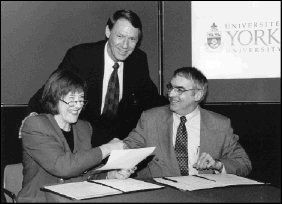
HAVE WE GOT A DEAL?: (Left to right) President Lorna Marsden, Minister of Education and Training Dave Johnson and Seneca College President Stephen Quinlan at the Jan. 7 signing ceremony.
A new articulation agreement between York's Faculty of Arts and the General Arts and Science program at Seneca College of Applied Arts and Technology gives incoming students an opportunity to obtain both a diploma from Seneca and a Bachelor of Arts degree from York within three calendar years of study.
The agreement, signed Wednesday, Jan. 7 by President Lorna Marsden and Stephen Quinlan, president of Seneca College, marks a breakthrough in co-operation for post-secondary institutions in Ontario by facilitating a flow of students from the college to the University.
Quinlan praised York's vision in joining in the endeavour.
"This initiative grew from years of Seneca students desiring to continue their education at university," he said. "It can serve as a model for other institutions to follow."
York's president agreed. "Partnerships such as these are the way of the future," Marsden remarked. "Students want a top-quality education and they want the skills that will help them get a job. This program attempts to provide them with both."
Under the agreement, students spend their first two years at Seneca being taught by faculty from both institutions. They must take a summer course at York after each of those years, followed by a third and final year spent entirely at York.
After entering Seneca, students have until the end of the first semester to express their intention to enrol in the York Articulation Program. In order to quality, they must pass all subjects and maintain a grade point average of 3.0 throughout the program.
"The program is intensive and certainly not for every student," said Dean of Arts George Fallis. "It requires students to work year-round, when many now go only part-time as they attempt to finance the rising cost of post-secondary education."
Numerous advantages
On the other hand, the advantages are numerous. They include the ability to ease into the academic experience at Seneca where students experience smaller classes and have a better opportunity to acquire the critical skills necessary in university. As well, there is considerable cost-saving in tuition fees.
Dave Johnson, Ontario's minister of education and training, was present at the signing to add his support to the program. "We want to be flexible and responsible to Ontario students," he said, "and to ensure that graduating students have useful and successful careers."
Faculty and staff from York and Seneca attended the signing, along with representatives from the federal and provincial governments and teachers and councillors from area high schools.
Simone Ziv, a student newly registered in the program, gave the final proof of its value to students in her remarks to the gathering. "Until this program came along I wasn't going on to university," she said. "Now I can see myself with a degree and a great future."
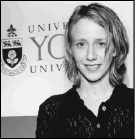
A GREAT FUTURE: Simone Ziv is the first student to enrol in the new joint program.
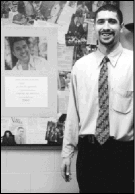
DISABLED AND PROUD:
Angelo Tocco is pleased the resource room is open and ready for use.
A new resource centre that will enrich the lives of the deaf and hard-of-hearing has been established at the University to commemorate the late Ron Cope, a York alumnus and tireless educator and advocate for those with hearing loss.
The official opening of the Ron Cope Gateway Resource Room on Monday, Jan. 12 was part of York's Disabled and Proud: Access Awareness Event 1998, which runs throughout January.
As a teacher of special education, Cope's commitment to deaf education went far beyond his own classrooms. He was a strong believer in the need to take deaf people out of institutions and integrate them into the regular school system. His belief in the need to provide deaf and hard-of-hearing students with the resources to participate in mainstream education led his friends and colleagues to establish the resource room in his honour.
"This was Ron's dream, that members of the public and students could freely access the kind of resources we have in the resource room, such as print, computer and audiovisual resources, a Web site for the deaf (http://
www.yorku.ca/admin/sa/roncope), and a telephone device for the deaf (TTY)," said Joseph Bobyk, a longtime friend of Cope's and the chair of the Ron Cope Fundraising Committee.
Cope earned his Bachelor of Arts from York in 1973 and went on to receive his master's degree in special education at the University of Toronto. His teaching career began at age 19 in a tiny, one-room schoolhouse in Footes Bay, Muskoka. When he died at age 51 in 1984, he was nearly finished a PhD in special education and was working as the director of support services for the hearing impaired and for the multi-handicapped at George Brown College of Applied Arts and Technology.
The fundraising committee has received extraordinary financial support from Cope's friends and colleagues and has raised more than $60,000 for the Ron Cope Memorial Fund.
The fund will not only help in the operation of the resource room, but it will also enable the University to offer the Ron Cope Bursary, an annual bursary for deaf, deafened and hard-of-hearing students. The bursary's value will be between $500 and $1,000, depending on the success of the Memorial Fund. The first student will benefit from the bursary next year.
At the opening of the resource room, Curtis Lecture Halls 117, visitors were given a guided information session by Rebecca Heiman and Angelo Tocco.
Heiman, who has moderate-to-severe hearing loss, is a mass communications and sociology student at York. She hopes to pursue a career as a university professor and writer of children's books. Tocco, who is profoundly deaf, is a recent York graduate with bachelor's degrees in physical education and teaching.
York is home to approximately 50 to 60 deaf or hard-of-hearing students.
"There couldn't be a better tribute to Ron Cope than to establish a resource room like this at York University," said Cora Dusk, York's assistant vice-president (student affairs).
"York is proud to be able to continue Ron's work by offering resources, not only for its deaf and hard-of-hearing students, but also for people in the wider community looking for information pertaining to the deaf community."
GANDHI AT YORK: (left to right) India's Consul General Rajeev Kumar Bhatia, President Lorna Marsden and Board of Governors member Dr. Rasik Morzaria celebrate the gift to York of a magnificent bronze sculpture of Mahatma Gandhi.
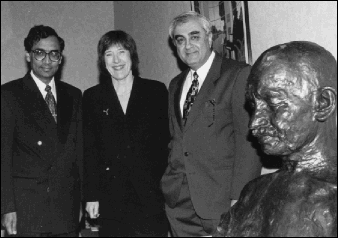
Rajeev Kumar Bhatia, India's consul general to Canada, presented a specially-commissioned, bronze bust of Mahatma Gandhi to the University, on behalf of the Government of India, at a brief ceremony early in January.
The impressive, larger-than-life sculpture, measuring 92 cm by 80 cm, was sculpted by Delhi-based artist Ram Sudar Singh and was specially commissioned for its installation at York, according to Rajiv Jain, a consulate spokesperson.
The sculpture was presented to the University as part of the celebrations of the 50th anniversary of India's independence. The Indian government credits Gandhi and his campaign of passive resistance with playing a significant part in achieving independence from Britain.
York was chosen as the recipient of the bust in recognition of the University's several connections with India, including the Centre for Asian Studies, the scholarly activities of a number of faculty members and the large number of students with an Indian heritage.
At a later, formal ceremony, the Gandhi sculpture will be permanently installed near the reflecting pool in the Scott Library.
International student enrolment at Canadian graduate schools continues to decline, according to The National Report on International Students in Canada: 1996/97, prepared by the Canadian Bureau for International Education.
Following are some highlights from the report:
International student enrolment at the university graduate level has experienced an 18.5 per cent decrease since 1992-93. The decrease was 4.2 per cent from 1995-96 to 1996-97.
The total international student population at the university level decreased for three consecutive years, dropping from 37,478 in 1992-93 to 31,435 in 1995-96. There are now more foreign university students in Australia than in Canada.
Between 1992-93 and 1995-96, the number of international students and trainees sponsored with Canadian Official Development Assistance decreased by almost 1,800 students. ODA-sponsored male students continue to outnumber female students by a ratio of three to one.
During the 12 years, 1985-86 to 1996-97, international enrolment in Canada increased dramatically at all levels except the university level. The bulk of the increase is attributable to non-traditional providers of education for example, private schools, private institutions in language training, and private institutions in technical business and health programs.
Ontario has experienced a substantial decline in international student enrolment since 1993-94. From 1995-96 to 1996-97, enrolment decreased 6.7 per cent.
The leading source countries of international students in Canada have changed markedly since 1994-95. From first place in 1994-95 with 12,300 students enroled, Hong Kong has moved to third place with only 9,205. Japan led in 1996-97 with 9,832.
South Korea has replaced the United States as the second leading source country with 9,743 students studying in Canada. However, the vast majority of South Koreans are at the college/trade level, while U.S. students are evenly split among college/trade, undergraduate university and graduate university.
In 1995-96, only seven of the 20 top Canadian host universities had at least 1,000 international students, as compared with 14 of the 20 in 1992-93.
The Gazette will report on York's recent experience with recruitment of international graduate students in an upcoming issue.
The 10th Annual Interdisciplinary Feminist Graduate Colloquium is inviting proposals for presentations of works, completed or in progress, that address any aspect of feminist studies or concerns.
The colloquium, March 2 and 3 at York, will provide a setting for graduate students to present their work and discuss feminist scholarship with people from various disciplines. The organizers encourage alternative and innovative presentations, including audio-visual presentations, performances, workshops and artistic productions.
Proposals or abstracts no more than one page should be sent to: Diane Crocker, Graduate Program in Sociology, 2071 Vari Hall, York University. The deadline for submissions is Monday, Feb. 2.
More information is available via email at: crockerd@yorku.ca.
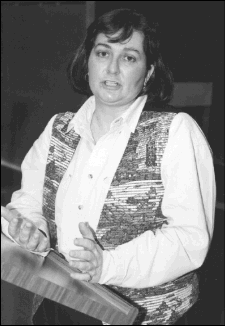
PREMIER STARTLED: "What startled Mike [Harris] the most was the impact of women on the picket lines," OPSEU President Leah Casselman informed York audience.
To the chagrin of Premier Mike Harris, women members of OPSEU (the Ontario Public Service Employees Union) had an enormous impact on the outcome of the five-week OPSEU strike in February and March of 1996, Leah Casselman is convinced.
"What startled Mike the most was the impact of women on the picket lines," Casselman, president of OPSEU, told a York University audience on Jan. 6, during the course of an address entitled "Women, Unions and Leadership: Personal and Political Perspectives."
Realizing the impact cuts to government programs would have, not just on their jobs, but also on their clients, the striking women OPSEU members "gathered strength from each other and became extremely militant," Casselman reported. "They formed flying squads. They really got into this."
Approximately 54 to 56 per cent of the 110,000 OPSEU members are women, said Casselman. Some 60,000 OPSEU members work directly for government, 25,000 are community college employees and the remainder are employed by government-related agencies and program providers.
The 1996 strike was the first for OPSEU the previous, NDP government having legislated the union's right to strike.
"The public were startled when they actually saw who was out on strike," the OPSEU leader said. Contrary to the all-too-common perception of civil servants as an under-worked and overpaid elite, they turned out to be "just ordinary people, including a lot of minority women."
The union's efforts during the strike succeeded in keeping language in the OPSEU contract that continues to stymie the government's efforts to downsize, Casselman said.
Elected just a month before the Mike Harris government took office, Casselman's first experience of union leadership was "a baptism of fire," she said. The new premier had formed a majority government on the basis of a promised tax cut and came out "guns blazing."
When the strike loomed, "people didn't think I could do it," Casselman recalled. "I was an unknown."
The challenge of union leadership is to move the membership forward with you, said Casselman, and the trick is to know how to do that most effectively. Women lead differently than men, she said. "You have to draw on your own internal skill sets and not apologize or over-compensate because you're a woman.
"It's important that women in leadership roles encourage others, model for others, make it easier for them by eliminating barriers," she said. "You don't want others to have to go through what you did. They should be able to participate to the fullest of their ability."
Currently, six of the 21 members on the OPSEU board are women, said Casselman, who supports affirmative action as a means of bringing more women into leadership roles in the labour movement.
"The labour movement is breaking out of its mould and becoming less traditional in its thinking," she said. "We have to make it much more relevant to other people and concentrate a little less on self-interest.
"Labour doesn't do a good job of explaining itself," Casselman said, citing the success of Ontario's teachers in sharing their grievances with the public during the 1997 teachers' strike as a positive example of how to get the public on-side.
Greater impact on women
The impact of "the big shift to the Americanization of the province" by Mike Harris falls disproportionately on women, Casselman believes. "Harris claims we can't afford social programs like childcare and care of the elderly, but we simply can't not afford them. We must fight to maintain them," she said.
"It's a matter of all of us not taking things for granted anymore, of thinking 'everything will be there when I need it.' Everything won't be there when we need it."
The Ontario premier is soft-spoken, so people don't see him for the radical ideologue he is, Casselman said. "There's one thing I'll give Harris credit for he has politicized hundreds of thousands of people" [through force-feeding his agenda].
OPSEU will do "everything we can to unseat the Tories," said Casselman. "My fantasy is that there would be some kind of coalition between the NDP and the Liberals in the next election."
Casselman, who has never belonged to a political party, described NDP leader Howard Hampton as "a very bright guy. He's much closer to the electorate than Rhodes Scholar Bob Rae."
Liberal leader Dalton McGuinty is "a funny guy," she said. "When I met with him, he enthused about the Liberal's high numbers in the polls. He wasn't happy when I told him, 'Ya, and you're invisible."
Casselman, 43, was first elected president of OPSEU on April 28, 1995. She is the union's first woman president. She is also a vice-president of the National Union of Public and General Employees and a vice-president of the Ontario Federation of Labour.
Born in Winchester, Ontario, south of Ottawa, Casselman joined the Ontario public service in 1978 with a degree in sociology from McMaster University. In 1981, she became vice-president of Local 213 at the Syl Apps Youth Centre in Oakville, where she worked as a correctional officer.
Casselman's speech to an almost-full house in the Moot Court room at Osgoode Hall Law School was presented by the Centre for Research on Work and Society and the Labour Studies Program.
Undaunted by the ice storm that was wreaking havoc throughout Eastern Ontario and Quebec, 87 hardy students in the MBA program at York's Schulich School of Business travelled to Laval University in Quebec City to compete against 12-15 other business schools in the 10th annual MBA Games, Thursday through Sunday, Jan. 8-11.
Their reward was to carry away the prestigious Goodwill Cup, the only award at the games that recognizes students' commitment to their community.
In 1997, Schulich MBA students devoted 650 hours to community work and raised $7,400 for the United Way Campaign and other worthy causes, says part-time student Paola Scorciello.
As well, as many as 100 MBA students have volunteered to assist SAVE (Students Against Violence Everywhere), an organization begun at the school in 1996 to assist abused women in moving from their homes to the North York Women's Shelter, says Scorciello, who is SAVE's past-president and advisor.
The Schulich MBA students also volunteer to participate in the non-profit Economics of Staying in School Program provided by the Junior Achievement organization. In 1996, Schulich students made several day-long presentations to elementary school classes, with an aim to promoting the value of education.
Almost half of York's first-year MBA class took the 13-hour bus ride to participate in the games, which entail academic, athletic and team-spirit competitions, says Lisa Rothschild, president of the Graduate Business Council at the Schulich School of Business.
"We probably deserved to win an award as the most injured team," Rothschild told the Gazette with a smile. The sports portion of the games included competitions in broom ball, soccer, kick baseball, inner-tube water polo and "something called kin-ball."
Though the team didn't place in the top three, Rothschild reports, they did extremely well in the academic portion of the games, especially considering that, unlike the other teams, through a mix-up they did not have sufficient time to prepare for the all-important case competition.
The academic element included a business simulation and general knowledge quizzes, while team spirit was demonstrated through ice-sculpture and mural competitions. The York team sported a uniform, consisting of baseball caps, nylon jackets and scarves supplied by the Graduate Business Council.
Students Michael Dymond and Jamie Grossman organized the expedition on behalf of the council.

by James Brown
The annual Society for Teaching and Learning in Higher Education Conference (STLHE '98) is coming up, June 24-27. This year's conference theme is "The Voices of Learning: Student and Teacher," and if you're looking for inspiration along with a lot of practical suggestions about your teaching you really should plan to attend. As an additional enticement, this year's conference is at Mount Allison University, set in the pastoral beauty of Sackville, New Brunswick.
I attended the STLHE conference in Regina last year, after too long an absence: I hadn't been to the annual conference since it was last held at York in 1992. Many York instructors were then, and have continued to be, very active with the Society. Pat Rogers for instance was then the director of York's Centre for the Support of Teaching and is now the president of STLHE.
I can't tell you what particular sessions will be offered at Mount Allison the call for proposals remains open until Jan. 23 and the organizers expect to publicize the final program in March. In the meantime, the website at www.mta.ca/stlhe98 remains the best source of information and is a very well organized and aesthetically pleasing site.
I can tell you what a marvelously inspirational experience last year's conference was secure in the knowledge that STLHE '98 will offer an experience of the same kind. STLHE is so highly interactive that "conference" isn't quite the right word for it. Just proposing a session involves specifying not only the title, description etc., but also your plans to "involve participants" in the session. At last year's STLHE, even the plenary sessions which are hard to make much more than presentations successfully engaged attendees as participants.
Last year's opening plenary featured Allan Gedalof on "Teaching Large Introductory Classes." Allan is a 3M Teaching Fellow and a wonderfully amusing presenter. For me, Allan's session fell into the category of "inspiration" what he does to engage students is too intimately tied to his personality and discipline for me to make much in the way of a specific transfer to mine. However, his joy in teaching is transparent and infectious I'm hoping for a booster shot this June.
Last year's second plenary featured Stephanie Pafenberg, who teaches German at Queens'. She was critical of too much fascination with technology, but presented her critique very effectively by projecting pages from her website. She also had some inventive ways of engaging us with small-group activities throughout the session. Ironically, it was her use of projected html which I subsequently adopted. I figure, why use Powerpoint (I've stopped) when webpages can be written to project so well in the lecture theatre and when they make such an easily accessible "archive" of the presentational material in the course?
My main feeling about STLHE concurrent sessions is a wish to clone myself. I went to some wonderful sessions: a dramatization of the process of peer consultation on teaching as it's conducted at the University of Alberta, which was a delight as a session and, I think, a real model program; and a wonderfully focussed session on "How Research and Theory Can Improve Your Practice."
STLHE has always been a great place to find out what your colleagues at York are doing: Jan Rehner did a terrific workshop on the Foundations program in Arts, and Jackie Buxton and Timothy Banks presented a wonderful session "Why I'm a Young Hip Teacher and Still Resist Technology" which everyone at the conference was talking about.
In many ways, it really is the casual conversations with colleagues before, after and in the interstices of the sessions themselves which make STLHE such a great experience that along with finding out that other caring teachers have some of the same problems and frustrations, as well as the joys and exhilarations, that you do.
You might try that experience in Sackville in June. You likely will bring back a bigger toolkit to your teaching and, more importantly, you'll return enthused, refreshed and inspired.
James Brown is associate director at York's Centre for the Support of Teaching. He can be reached via email at: jamesb@yorku.ca.
Speaking of Teaching is a regular column edited by the Centre for the Support of Teaching. If you have an idea that works, a concern about teaching or a view you would like to express, please send it to us in Room 111 Central Square or call us at 736-5754, and we'll try to include it in a future column. Longer items will be considered for publication in the Core Issues newsletter. Our Internet home page is: http://www.yorku.ca/admin/cst/

Shapson appointed to the Council of the Ontario College of Teachers
Stan Shapson, dean of the Faculty of Education, has been appointed to the Council of the Ontario College of Teachers.
The council deals with the regulation of teaching certificates, standards of practice and discipline. It is made up of 17 elected chairs and 14 public appointees from across the province.
Shapson also serves on the Accreditation Committee, responsible for accrediting programs by faculties of education.
"The College of Teachers tackles education issues of great importance for the future of public education in Ontario," says Shapson. "Lending my voice to representing the public on the council is a privilege, and a responsibility I am pleased to take on."
The College of Teachers was established by proclamation of Bill 31 on July 5, 1996 and began officially in May 1997. Certified teachers employed by a school board are registered automatically with the college. All others who hold an Ontario Teacher's Certificate and who wish to maintain their credentials are required to register themselves with the college.
"The college is a stand-alone, self-regulating body," says Margaret Aubé, senior research analyst with the college, "and is self-funded by its members."
To date, the major activities of the Council of the Ontario College of Teachers have included approval of a code of ethics for council members, Aubé says. A new, professional misconduct by-law is among the by-laws currently being established for members of the college.
The council's Discipline Committee is responsible for making the final decision on disposition of the approximately 30 discipline cases that are expected to come before it annually.
Before joining York in 1990, Professor Shapson was associate dean and director of professional and undergraduate programs and professor at Simon Fraser University.
His main academic interests include teacher education, program development and evaluation. He has been actively involved in collaborative programs with school boards, field-based programs for teachers and the development of teacher education programs addressing linguistic and ethnocultural diversity.
He has published in a variety of publications and directed large-scale studies funded by the federal and provincial governments. His research and publications have received awards from such organizations as the American Educational Research Association and the Canadian Journal of Education.
Prof. David Vaver elected to new chair at Oxford in Intellectual Property Law
Professor David Vaver, Osgoode Hall Law School, has been selected as the first holder of a new chair in Intellectual Property Law at Oxford University, effective July 1.
As well as chairing the Reuters Professorship in Intellectual Property and Information Technology Law, he will become director of the Oxford Intellectual Property Research Centre at St. Peter's College, Oxford and will be a professorial fellow of the college.
Vaver has been a professor of law at Osgood Hall Law School since 1985.
Prof. Shelley Hornstein was a panelist for discussion of art and the Holocaust
Shelley Hornstein, associate professor of Art History and chair of Fine Arts, Atkinson College participated in a panel discussion on the subject of "Topographies of Evil: Auschwitz and the Politics of the Aesthetic," on Sunday, Jan. 18 in the Hal Jackman Room at the Art Gallery of Ontario.
Prof. Hornstein co-edited Capital Culture: A Reader on Modernist Legacies, State Institutions, and the Value(s) of Art (1998). Currently, she and Florence Jacobowitz are working on a book entitled, Culture, Memory and Resistance: Representation and the Holocaust.
The panel discussion was presented by Atkinson College, the Canadian Centre for German and European Studies and the Art Gallery of Ontario.
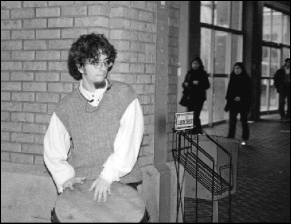
Recently, Simon Handley visited the Keele campus as part of his 22-day, busking journey across southern Ontario and parts of Quebec. While at York, the itinerant percussionist (shown here in the Student Centre) made big sounds on his large African drum.

As a new book by York history professor Christopher Armstrong demonstrates, the Bre-X saga is only the latest and most spectacular in a series of mining-stock scams by Canadian fraud artists.
"By the turn of the [20th] century," Armstrong writes in the introduction to Blue Skies and Boiler Rooms: Buying and Selling Securities in Canada, 1870-1940 (University of Toronto Press, 1997, $39.95 cloth), "worthless stock in fly-by-night undertakings was being peddled by smooth-talking con men who, it was said, did not scruple to offer a simpleton shares even in the blue sky above."
Though, by 1912, governments in Canada were beginning to regulate securities markets, whether by blue-sky laws, anti-fraud statutes or the creation of specialized tribunals, investors continued to display "an astonishing combination of cupidity and naivety," throughout the period covered by the book.
Following is an excerpt from Blue Skies and Boiler Rooms:
Stephen Leacock captured the popular mood of enthusiasm for taking a flyer on mining stocks perfectly in Sunshine Sketches of a Little Town (1912). To the people of the mythical Mariposa, a hundred miles north of Toronto,
"it seemed like the finger of Providence. Here was this great silver country spread out north of us where people had thought there was only a wilderness ...
"So no wonder the town went wild. All day in the streets you could hear men talk of veins and smelters and dips and deposits and faults the town hummed with it like a geology class on examination day. And there were men about the hotels with mining outfits and theodolites and dunnage bags, and at Smith's bar they would hand out chunks of rocks up and down, some of which would run as high as ten drinks to the pound."
At the beginning of 1907, with the Cobalt boom going full tilt, John B. Maclean brought out his new Financial Post. The publisher of the Canadian Grocer, the Dry Goods Review, and Hardware and Metal had concluded that the businessmen who read his other publications needed information and advice on investments. A weekly devoted to financial news would fill a niche that the commercial papers largely ignored. As editor, Maclean chose Stewart Houston, who was determined to pull no punches. The very first issue of the Post carried a pointed warning: "Mining stock should be bought only by men who have made mining a business, or the rich individuals who can afford the hazard a mining proposition inevitably entails."
"Consulting Engineer," the paper's Cobalt correspondent, warned repeatedly against accepting the reports of self-styled "Mining Engineers." Most mining prospects were wildcats whose "very sharp teeth and claws were plentiful, and in nine cases out of ten the unscrupulous mining engineer was largely responsible for them being at large." Consulting Engineer also pooh-poohed the push of exploration 50 miles north from Cobalt into the Larder Lake gold country, predicting that 95 per cent of the claims would be thrown out when the mining recorder established that the prospectors had not made the required mineral discovery. To invest without the fullest information on an ore body was "blind gambling with the odds always against the shareholder."
Eventually even the sceptics had to admit the richness of northern Ontario as one dramatic find succeeded another, like the great gold discoveries at Porcupine near Timmins in 1909 and at Kirkland Lake in 1912. But while the boom in mining shares raced ahead some people still worried that investors continued to be swindled left, right, and centre. As early as 1904, before the Cobalt rush was fully under way, one member of the Ontario legislature had introduced a private member's bill to revamp the provincial Companies Act along the lines of the British revisions of 1900, requiring promoters to make extensive disclosure by prospectus. In the debate a government spokesman claimed that investors already had more protection in Ontario than elsewhere, and no action was taken.
By 1907, however, the Ontario cabinet had finally decided that the time had come to revise the law. Provincial Secretary W.J. Hanna drafted a bill based upon the British act of 1900. The new legislation not only required all companies with more than ten security holders to make much fuller disclosure by issuing prospectuses, but it rendered void stock subscriptions solicited verbally unless a written prospectus was also delivered to the buyer. The Monetary Times warmly applauded the new law and suggested that all other governments should follow suit to ensure a uniform regimen across the country; but Ottawa and the other provinces failed to act.
With the Cobalt mining boom in full swing, however, it was clear that new company legislation alone would not be sufficient to protect the gullible from themselves. In the fall of 1907 the Financial Post began working to educate the public through a weekly "Black List" (printed in special bold type), which described the more outrageous stock-selling operations. Some of the mines on the list were out-and-out frauds, such as Highland Mary; Toronto broker Frank Law was shown to have used ore samples sent to him by a completely different company to bilk the public and was charged with conspiracy to defraud. He was convicted of swindling share buyers of $235,000 and sent to the penitentiary for five years.
The Financial Post also revealed how easily shady mining promoters could skate round the law. For instance, the backers of the Silver Leaf Mining Company created 5-million $1 par-value shares and struck a deal with a Toronto brokerage to sell them for whatever it could get on a commission of 40 per cent, the balance to go into the company treasury. Some 2-million shares were apparently sold for about $140,000, or just under 15 cents per share. In one community a well-known investor was persuaded to buy shares and was paid a dividend to induce him to recommend the stock to others without his realizing that his neighbours would receive no such dividends. The $85,000 owed to the company treasury was never paid over, but simply kept by the insiders.
In an effort to convince the Toronto financial community that there were plenty of sound mining companies, the town of Cobalt invited a large delegation from the Toronto Stock Exchange to visit in the fall of 1908. The brokers were wined and dined by town officials and miners, who tried to impress upon them that the "rush" was over and that the stage was now set for more orderly development of the mines. Yet evidence of how common such swindles remained at that time was one Cobalt promotion that attracted great attention from the Toronto mining fraternity because of the unusual approach taken by the sponsoring brokers. Though located near other valuable mineral finds, the company's property was simply represented as a prospect that might or might not turn out. Moreover, the insiders committed themselves to maintaining their interest in the company until the claims had been thoroughly explored. In addition, investors were promised that there would be no "clean-out" at their expense once share prices had been run up as the insiders abandoned the stock. The comment that this proposition aroused indicates how exceptional these commitments were.
Reprinted with permission from the University of Toronto Press. (Professor Armstrong currently is at work on a companion volume, to be entitled Moose Pastures and Mergers: The Ontario Securities Commission and the Evolution of Share Markets in Canada, 1940-1980.)
.gif)
The 1997 York University United Way Campaign has surpassed its goal of $97,000 and, when all the donations have come in and any last-minute pledges have been counted, organizers expect the total contribution to exceed $105,000.
As of Jan. 12, the total stood at $104,686.
"This is the first time in a long time that we have reached our target," says Community Relations Coordinator Warren Lee. "Surpassing it is a wonderful achievement it's the icing on the cake."
Though participation in the campaign remains at 12 per cent of potential contributors, Lee says, "at least it hasn't dropped this year, as it has in the past three."
The Gazette will publish the total funds raised in its Jan. 28 issue.
The United Way of Greater Toronto has 144 member agencies, ranging from battered women's shelters, distress line and homeless shelters to community gardens, meals on wheels and health care support services.
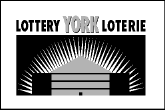
The winner of the December draw was Holly Pittman in the Registrar's Office with ticket number 1497.
Super-salesperson Debbie Jamieson in Communications was the ticket seller.
Following are the dates of the next four draws: Jan. 23, Feb. 27, March 27 and April 24.
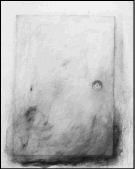
Door, Betty Goodwin, 1975-1976; graphite, acrylique, crayon de couleur sur carton.
La Collection Lavalin du Musée d'art contemporain de Montréal.
A selection of works from the Lavalin Collection of the Musée d'art contemporain de Montréal entitled, "Drafts and Drawings: From line to space, from experimentation to experience" is on display at the Glendon Gallery until Jan. 29.
The exhibition includes works by Jocelyne Alloucherie, Betty Goodwin, Lyne Lapointe, Francine Larivée, David Moore, François Morelli, Roland Poulin, Henry Saxe, Stephen Schofield, Serge Tousignant, Irene F. Whittome and Alex Wyse. It was organized and is being circulated by the Musée d'art contemporain de Montréal with the generous support of the Department of Canadian Heritage.
Following is a discussion of the exhibition by Josée Belisle, curator of the Montreal museum, translated and revised by Erin Mouré:
"This exhibition comprises approximately 20 drawings, produced for the most part during the 1980s. All of them engage the same medium, paper, deploying strategies that play out diverse intentions.
"Drawing can generally be considered from two main standpoints. The first and more traditional view is that it is a means of representing things: the principle of "imitating nature." But drawing is also, in a broader sense, a "projection" of the person executing it; seen this way, it gives concrete form to a sensation, an intuition, a feeling, an emotion, an idea, a concept.
"As a tool of experimentation, research, and learning, drawing encompasses a wide spectrum. Between the precise line that unequivocally renders the model to be represented, and the folded paper that "draws" a line without the touch of any instrument, all graphic treatments are possible: restless or precise gesture; repetitive, fine or harsh stroke; splotch; hatching; collage; plays on scale; network systems, whether simple or complex, planned or impulsive. The works exhibited here exemplify the striking variety of explorations in drawing today."
The hours of the Glendon Gallery, which is located on the Glendon College campus at 2275 Bayview Avenue, are Monday-Friday, 9 a.m.-5 p.m.; Sunday, noon-5 p.m.
Photo: Richard-Max Tremblay
RESEARCH CENTRES AT
YORK UNIVERSITY:
A LOOK AT THE CONCEPT
AND POLICY
Over many years, research centres have emerged at York University. There are now twenty research centres reflecting a wide range of interests, activities and participation. Centres have proven to be one of the effective mechanisms for encouraging cross-disciplinary research and teaching.
The President will establish a task force charged with reviewing the general administrative structure and support for research centres at York University. The task force will not deal with the mandates of, or review, existing centres. These are matters of Senate business. Rather, this project is part of a more general focus on research issues.
OVERVIEW FOR THE TASK FORCE
A) The Centres:
1. The definition of a research centre (as opposed to a school or an institute). Should there be different "kinds" of centres, reflecting different realities of, and opportunities for, research?
2. In an administrative sense, what kinds of centres should York University have? Should all centres have the same general mandate with respect to, for example, financial independence or linkage to external constituencies?
3. How does/should the University monitor the accountability of the centres?
4. What should the University expect from its centres? What should the centres expect from the University?
5. Is the distinction between Faculty- and University-based centres a useful one?
6. At what point should a centre cease to exist?
B) The Membership:
1. What are appropriate types of membership in centres?
2. What minimal terms and conditions of membership should apply to those associated with the centres?
3. What models of governance should apply to centres?
4. What are the centres' obligations to their members? What are the members' obligations to the centre and their home departments?
C) University Support:
1. What services should the University provide to centres? This should include issues such as staffing, administration, accounting, financial, and space, as well as questions about assistance in fundraising.
2. What overhead arrangements should the University have with research centres?
TASK FORCE MEMBERSHIP
1. Chair: Professor H. V. Nelles
2. Two members representing the Senate Committee on Research: Professor D. Johnston and Professor S. Tweyman
3. The Director of the Office of Research Administration: Ms N. Swatman
4. Representative of the Vice-President (Academic Affairs): Professor K. Davey
5. Representative of the Vice-President (Administration): Ms A. Uppal
6. Administrative Support: Ms P. Spence
PROCEDURES
1. Review the situation at York University
2. Compare it to the situation(s) elsewhere
3. Consult with Directors of Research Centres
4. Consult with Deans and Principal of Faculties
5. Consult the community (students, faculty, staff)
6. Provide interim reports before finalization of centre budgets
7. Report to the President by 31 May 1998
REPORTING
The President will make the Report available to Senate and/or appropriate Committees of Senate, accompanied by an Executive Response no later than September 1998.
December 11, 1997
The Task Force would welcome submissions from any member of the York Community on these or any other matters which might fall within its Terms of Reference.
Written submissions to the Task Force should be received no later than February 27, 1998 and addressed to:
H.V. Nelles
Chair, Task Force on Research Centres
Department of History
2184 Vari Hall
Work continues on the $30-million Seneca-at-York building, slated for completion in December.
The building's four wings of approximately 270,000 gross square feet will constitute a quadrangle surrounding a small courtyard. The south and east wings, each three floors in height, will converge to form the main entrance to the building at the southeast corner. The north and west wings, two storeys high, will blend with the surrounding University architecture.
The Seneca-at-York "Advanced Technology Campus" will be wired in a flexible architecture and will accommodate approximately 4,000 students through the use of new educational technologies. It will integrate computer and library resources into an "information commons" equipped with state-of-the-art information access and retrieval tools, general purpose micro-computer labs, project rooms, quiet study space and audio-visual services.
Classrooms will be provided in a variety of configurations that allow for different teaching/
learning modes: traditional and multi-tiered classrooms, two large lecture theatres and a "kaleidoscope" room fitted for multi-media and video conferencing presentations.



Photos by William Conway, courtesy of the Daily Commercial News and William Conway
Deadline Dates
January 31
Canadian Diabetes Association (CDA): Young Scientist Award
Canadian Red Cross Society (in conjunction with Bayer): Research and Development Fund (letter of intent due; full application is due April 1)
Canadian-Scandinavian Foundation: Grant and Scholarship Program
Centre for Studies in Religion and Society (University of Victoria): Non-Stipendiary Visiting Research Fellowships
French Embassy in Canada: Chateaubriand Scholarship Program
German Academic Exchange Service (DAAD): "Learn German in Germany" for Faculty
Transportation (Ontario Ministry of): Coordinator of Highway Safety Research Grant Program
early February
Foundation for Legal Research: Funding for Legal Research
February 1
American Schools of Oriental Research: Committee on Mesopotamian Civilization (Baghdad) Mesopotamian Fellowship; Cyprus American Archaeological Research Institute (Nicosia) Charles U. and Janet C. Harris Fellowship; Endowment for Biblical Research (Boston) Summer Research Grant and Summer Travel Scholarships
Association of Universities and Colleges of Canada (AUCC): Department of National Defence (Various Fellowships)
Canadian Red Cross Society (in conjunction with Bayer): Research Fellowship
Embassy of the People's Republic of China in Canada: China/Canada Scholar Exchange Program
German Academic Exchange Service (DAAD): Grants for Information Visits
Hansen (Rick) Man in Motion Foundation (in cooperation with the Alberta Paraplegic Foundation): Fellowships
Health and Human Services (U.S. Department of): Public Health Service Grants
MacArthur (John D. and Catherine T.) Foundation: Program on Peace and International Cooperation: Research and Writing Grants for Individuals
McLean Foundation: Grants
National Cancer Institute of Canada (NCIC): Personnel Support (Various Awards)
National Multiple Sclerosis Society: Advanced Postdoctoral Fellowships; Junior Faculty Awards; Postdoctoral Fellowships; Research Grants; Senior Faculty Awards
NATO: Science Program (Advanced Study Institutes)
York University (administered by ORA): Specific Research Grants; York Incentive Grant
York University's Centre for the Support of Teaching: CUPE Teaching Development Grants
Onassis Public Benefit Foundation
Research and Educational Grants and Scholarships
The Onassis Public Benefit Foundation provides grants and scholarships in order to support foreign scholars and researchers of humanistic and political sciences, to Hellenists, to teachers of the Greek language, to artists and translators of Greek literature. The award includes a monthly remuneration, plus travel expenses. The duration of the award is between one to six months.
Deadline: January 30
Canadian Police Research Centre
Research Development Proposals.
The Canadian Police Research Centre is interested in developing partnerships with university researchers that focus on research, development, and evaluation of police equipment. The objective is to develop technologies and equipment that help police complete their duties more efficiently, effectively, and safely.
Deadline: Proposals can be submitted at any time.
Ontario Ministry of Transportation
Coordinator of Highway Safety Research Grant Program
This grant program encourages basic and applied research on the behavioural, economic, and social aspects of highway safety, from educational activities to theoretical problems of traffic crash analysis. Funds for feasibility studies are also available. The total value of the awards is approximately $130,000 each year, and it is expected that up to six grants will be funded. The duration of the grant is up to two years. Funds are also available for feasibility studies for up to one year.
Deadline: January 30
Centre for Excellence on Research on Immigration and Settlement (CERIS)
Request for Proposals
CERIS is seeking proposals that promote research into the impact of immigration on the Greater Toronto Area and on the integration of immigrants into Canadian society; to allow for the provision of training opportunities; and to disseminate policy and program-relevant research information. CERIS is requesting research proposals in the following areas: Children and Youth; Cohesion, Citizenship, and Social Climate; and Institutional Restructuring and Policy Change. A total of $150,000 is available to be divided between 5 and 10 projects.
Deadline: March 3
![]()
The Office of Research Administration (ORA) would like to remind faculty members of these research opportunities with upcoming deadlines. Deadlines listed are those of the granting agencies. Applications for external sources of funding (i.e., outside York) must be submitted to ORA before forwarding them to the agencies. To assist in meeting these deadlines, it is recommended that applications be submitted to ORA one to two weeks prior to the deadline dates.
For more information, please contact ORA at -55055 in S414 Ross Building (e-mail: research@yorku.ca).
Senate's Academic Policy and Planning Committee will hold a series of public meetings on options for Glendon College in February and March. The meetings will follow on the release of a discussion paper in February, and are scheduled for the following times and places:
Tuesday, Feb. 24: Board/
Senate Chamber, York Hall, Glendon College, 7 to 9 p.m.
Tuesday, March 3: Senate Chamber, Ross Building, Keele Campus, 7 to 9 p.m.
Wednesday, March 4: Senate Chamber, Ross Building, Keele Campus, 4 to 6 p.m.
Thursday, March 5: Cafeteria, York Hall, Glendon College, 1:30 to 3:30 p.m.
Friday, March 6: Senate Chamber, Ross Building, Keele Campus, noon to 2 p.m.
Any changes to this schedule will be announced in advance. For further information, please contact the University Secretariat at (416) 736-5012.